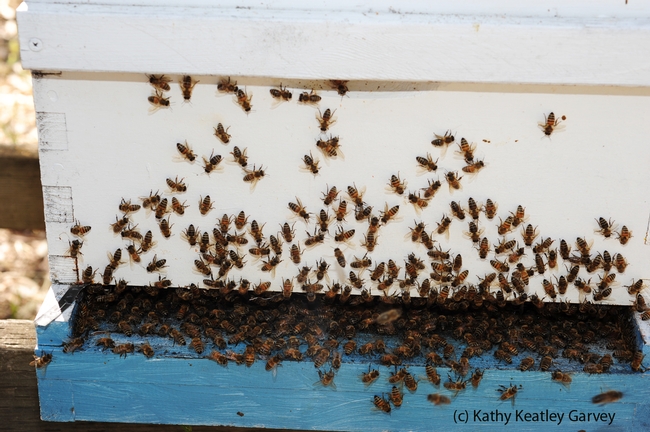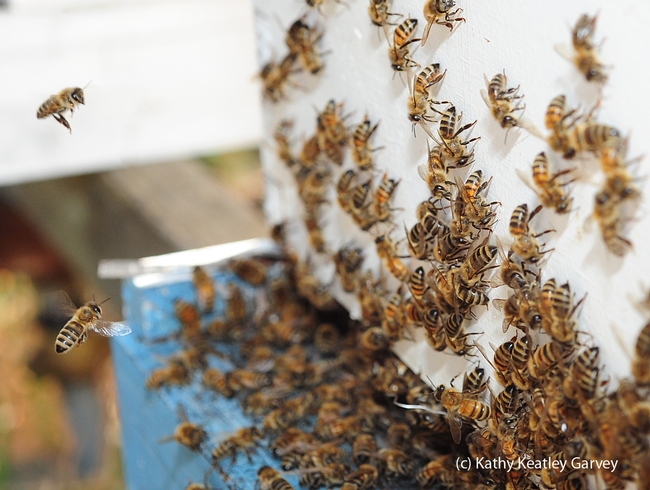- Author: Kathy Keatley Garvey
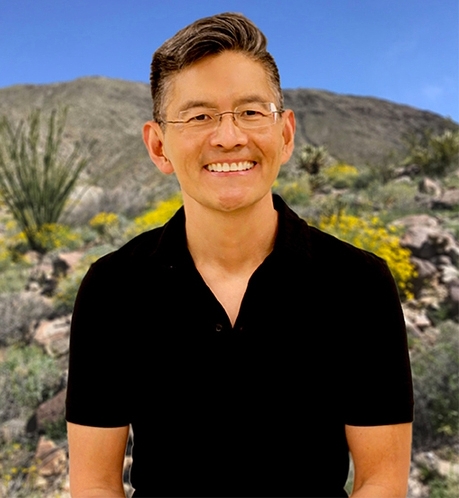
You're dancing in the dark, on a small, crowded dance floor with lots of obstacles, and you're trying to communicate to other foragers where that great resource is. You're relating the direction, distance, and quality of the resource (pollen, nectar, propolis, or water) so that they too, can find it, collect it and return it to the hive.
Can you do that? And also perform other communications, like letting the colony know where a good nesting site is?
No?
Want to learn more about honey bee communication?
Enter bee biologist James Nieh, a professor and an associate dean at UC San Diego. He'll present a seminar, hosted by the UC Davis Department of Entomology and Nematology, at 4:10 p.m., Monday, Dec. 4 in Room 122 of Briggs Hall. His seminar, "Danger, Dopamine, and Dance: New Insights from the Magic Well of Honey Bee Communication," also will be on Zoom. The Zoom link:
https://ucdavis.zoom.us/j/95882849672
Nieh, who is a faculty member of the Section of Ecology, Behavior, and Evolution, Division of Biological Sciences, and associate dean of Biological Sciences, has studied honey bee communication for decades.
"Karl von Frisch referred to the waggle dance as the 'magic well' for the insights that it provides not only on honey bees, but on the general cognitive complexity that social insects are capable of," he writes in his abstract. "New research demonstrates that the neurotransmitter, dopamine, the 'pleasure molecule' plays a similar hedonic role in honey bees as it does in many vertebrates, regulating the perception of danger and the anticipation of food rewards as revealed in the excitatory waggle dance and the associated, inhibitory stop signal. I will also discuss new data showing that the honey bee waggle dance is partially learned and has elements that may be culturally transmitted. Together, these findings, demonstrate that the waggle dance can teach us a great deal about shared cognitive mechanisms and the importance of social learning across taxa."
In an article, "Social Signal Learning of the Waggle Dance in Honey Bees," published in Science in March, 2023, Nieh and his research team showed that "correct waggle dancing requires social learning. Bees without the opportunity to follow any dances before they first danced produced significantly more disordered dances with larger waggle angle divergence errors and encoded distance incorrectly. The former deficit improved with experience, but distance encoding was set for life. The first dances of bees that could follow other dancers showed neither impairment. Social learning, therefore, shapes honey bee signaling, as it does communication in human infants, birds, and multiple other vertebrate species. that correct waggle dancing requires social learning. Bees without the opportunity to follow any dances before they first danced produced significantly more disordered dances with larger waggle angle divergence errors and encoded distance incorrectly. The former deficit improved with experience, but distance encoding was set for life. The first dances of bees that could follow other dancers showed neither impairment. Social learning, therefore, shapes honey bee signaling, as it does communication in human infants, birds, and multiple other vertebrate species."
Nieh received his bachelor's degree from Harvard University in 1991 and his doctorate from Cornell University in 1997. He completed a postdoctoral fellowship funded by NSF-NAT0 (National Science Foundation, North Atlantic Treaty Organization) at the University of Würzburg, Germany. He served as a Harvard Junior Fellow from 1998-2000.
Seminar coordinator is Brian Johnson, associate professor, UC Davis Department of Entomology and Nematology. For Zoom technical issues, he may be reached at brnjohnson@ucdavis.edu. The list of seminars is posted here.
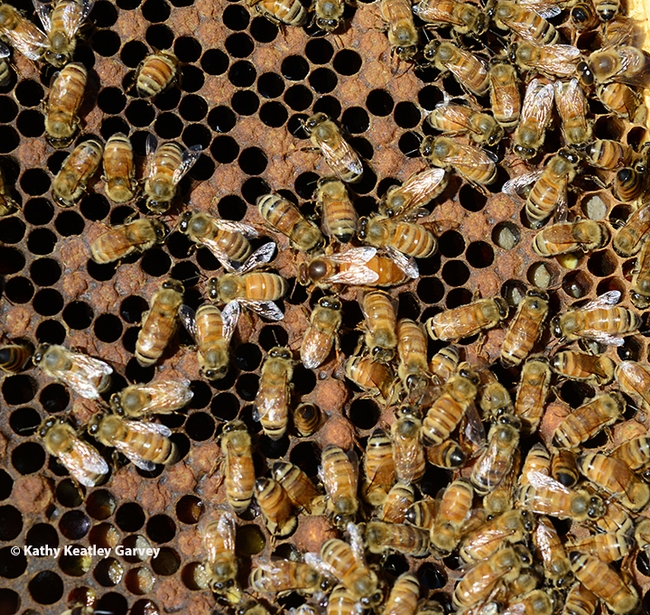
- Author: Kathy Keatley Garvey
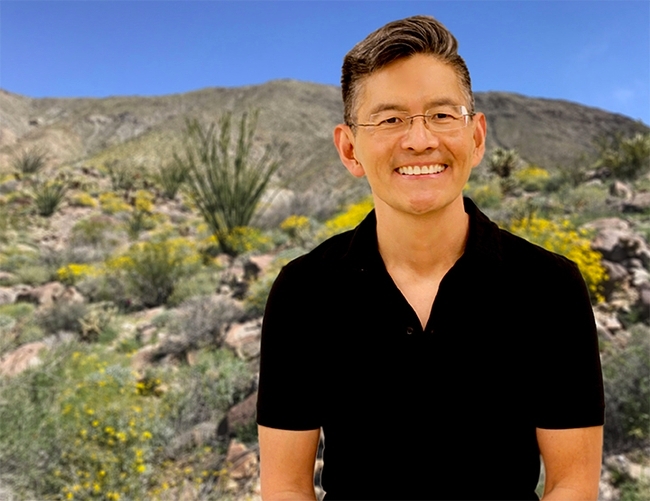
The next UC Davis Department of Entomology and Nematology seminar will feature professor James Nieh, a bee biologist in the Section of Ecology, Behavior, and Evolution, Division of Biological Sciences, UC San Diego and associate dean in the Division of Biological Sciences.
He'll speak on "Danger, Dopamine, and Dance: New Insights from the Magic Well of Honey Bee Communication" at 4:10 p.m., Monday, Dec. 4 in Room 122 of Briggs Hall. The seminar also will be on Zoom. The Zoom link:https://ucdavis.zoom.us/j/95882849672
"Karl von Frisch referred to the waggle dance as the 'magic well' for the insights that it provides not only on honey bees, but on the general cognitive complexity that social insects are capable of," Nieh writes in his abstract. "New research demonstrates that the neurotransmitter, dopamine, the 'pleasure molecule' plays a similar hedonic role in honey bees as it does in many vertebrates, regulating the perception of danger and the anticipation of food rewards as revealed in the excitatory waggle dance and the associated, inhibitory stop signal. I will also discuss new data showing that the honey bee waggle dance is partially learned and has elements that may be culturally transmitted. Together, these findings, demonstrate that the waggle dance can teach us a great deal about shared cognitive mechanisms and the importance of social learning across taxa."
In an article titled "Unlocking Secrets of the Honeybee Dance Language--Bees Learn and Culturally Transmit Their Communication Skills," and published March 9, 2023 in The Conversation, Nieh described the waggle dance as "one of the most complicated examples of nonhuman communication. They can tell each other were to find resources such as food, water, or nest sites with a physical 'waggle dance.' this dance conveys the This dance conveys the direction, distance and quality of a resource to the bee's nestmates."
Nieh related exactly how the bees perform the waggle dance. "Essentially, the dancer points recruits in the correct direction and tells them how far to go by repeatedly circling around in a figure eight pattern centered around a waggle run, in which the bee waggles its abdomen as it moves forward. Dancers are pursued by potential recruits, bees that closely follow the dancer, to learn where to go to find the communicated resource."
"Longer waggle runs communicate greater distances," Nieh wrote, "and the waggle angle communicates direction. For higher-quality resources such as sweeter nectar, dancers repeat the waggle run more times and race back faster after each waggle run."
Nieh noted that "The Greek historian Herodotus reported over 2,000 years ago on a misguided forbidden experiment in which two children were prevented from hearing human speech so that a king could discover the true, unlearned language of human beings.
"Scientists now know that human language requires social learning and interaction with other people, a property shared with multiple animal languages. But why should humans and other animals need to learn a language instead of being born with this knowledge, like many other animal species?"
Nieh went on to point out that "This question fascinates me and my colleagues and is the basis for our recent paper published in the journal Science. As a biologist, I have spent decades studying honeybee communication and how it may have evolved."
Nieh received his bachelor's degree from Harvard University in 1991 and his doctorate from Cornell University in 1997. He completed a postdoctoral fellowship funded by NSF-NAT0 (National Science Foundation, North Atlantic Treaty Organization) at the University of Würzburg, Germany. He served as a Harvard Junior Fellow from 1998-2000
Seminar coordinator is Brian Johnson, associate professor, UC Davis Department of Entomology and Nematology. For Zoom technical issues, he may be reached at brnjohnson@ucdavis.edu. The list of seminars is posted here.
Resources:
- Social Signal Learning of the Waggle Dance in Honey Bees, March 9, 2023, Science
- Bees Can Teach Their Young to Dance, March 9, 2023, Washington Post
- The Waggle Dance, PBS documentary on YouTube
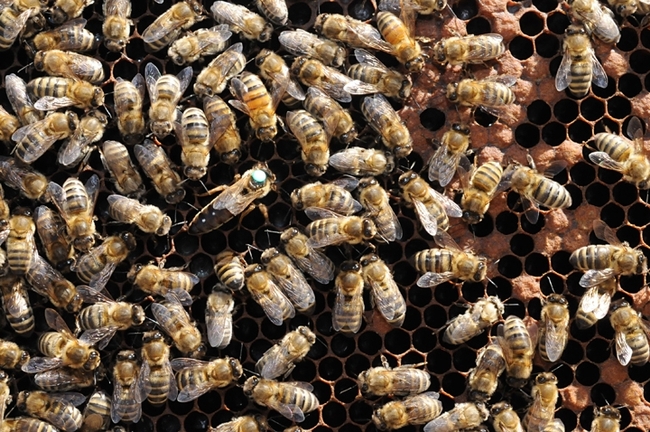
- Author: Kathy Keatley Garvey
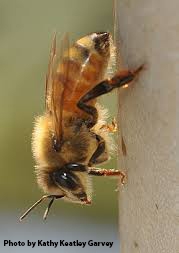
The grant, titled "Strengthening Honey Bee Health and Crop Pollination to Safeguard Food Availability and Affordability," and headed by principal investigator Boris Baer, a UC Riverside professor of entomology, also includes Davis, San Diego and Merced campuses. “I'm very excited about so many different kinds of bee expertise joining forces through this project,” Baer said.
Honey bees pollinate more than 80 agricultural crops, including almonds, apples, blueberries and cherries. The pollination services of these tiny agricultural workers account for about a third of the American diet. However, pesticide exposure, spread of parasites and pathogens, habitat destruction and environmental changes are challenging beekeepers, resulting in decreased pollination services and increased food prices.
The grant is an important one. Co-principal investigator Extension apiculturist Elina Lastro Niño of the UC Davis Department of Entomology and Nematology, which operates the Harry H. Laidlaw Jr. Honey Bee Research Facility, says it well: "Most excitingly, this funding will not only support research that will help improve pollinator health so crucial for California's agriculture, but it will provide opportunities for training of students and postdoctoral scholars. Work focused on improving honey bee stocks via novel tools aligns well with ongoing work in the Niño lab and will further cement collaborations with beekeepers and growers.”
Niño, who works closely with California beekeepers, launched and directs the California Master Beekeeper Program, which uses science-based information to educate stewards and ambassadors for honey bees and beekeeping.
Other co-principal investigators are James Nieh and Joshua Kohn of UC San Diego, and a trio from UC Riverside: Kerry Mauck, Tsotras Vassilis, and Kim Hyoseung. At Merced, Marilia Palumbo Gaiarsa serves as a co-investigator.
The UC scientists plan a three-pronged approach to resolve the issue: develop better breeding programs, better medications and treatments, and better tools to monitor bee health in the hives. Small “listening and smelling” devices will be placed inside the hives to monitor bee health.
"Safeguarding honey bees and their pollination services requires beekeepers to be better able to manage the health and survival of colonies, which requires research into the causal factors and interactions affecting pollinator health, and the development and implementation of novel tools in close collaboration with industry partners. To do this, we will form a California wide, cross disciplinary research network and
- experimentally study the ecological and molecular factors and their interactions that affect honey bee health and their interactions to identify biomarkers of their health
- use the knowledge gained to develop and deliver new, effective solutions for stakeholders, including remote sensing of bee health, a marker-assisted breeding program, and the development of novel medications,
- build a research industry nexus to conduct collaborative research. We will also develop and deploy new extension and outreach modules that will be offered through UC Cooperative Extension statewide. We will support California beekeepers to build and maintain a sustainable and profitable beekeeping industry, which has implications for food security on a national level."
The co-principal investigators also noted in their grant proposal that "The current coronavirus pandemic and impending recession is putting more pressure on agriculture to provide sufficient and affordable food. Honey bees are key to such efforts, and supporting a California based beekeeping industry also decreases the state's dependence on managed pollination from elsewhere, thereby creating new jobs and income."
Funding also will help provide research opportunities for undergraduates, including underrepresented students, with the goal of ensuring that the pipeline of students who enter research, academia, industry, and multiple other professions reflects the diversity of the communities in which they learn and work.
This is all a win-win situation.
As Kohn said in a UC San Diego news release: “This network of bee researchers comprises a unique mixture of expertise that can apply highly multidisciplinary approaches to benefit the honey bee industry essential to the production of many of California's most economically important crops."
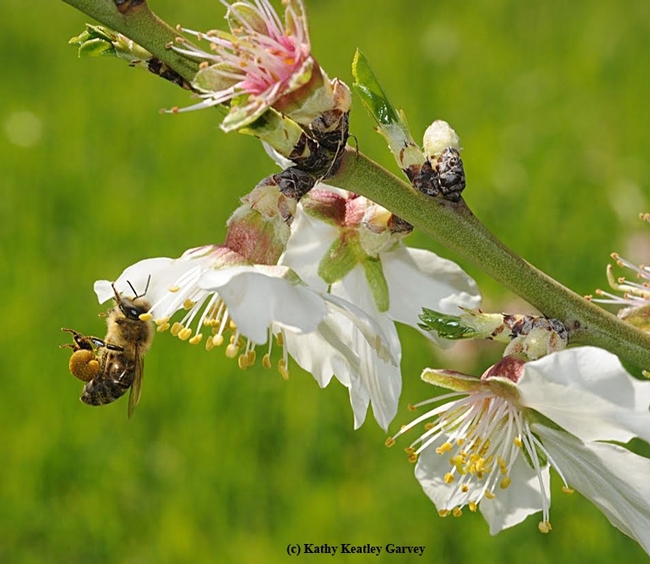
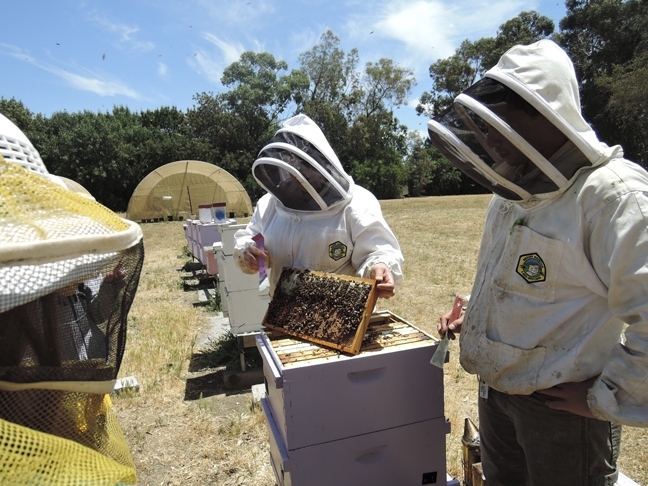
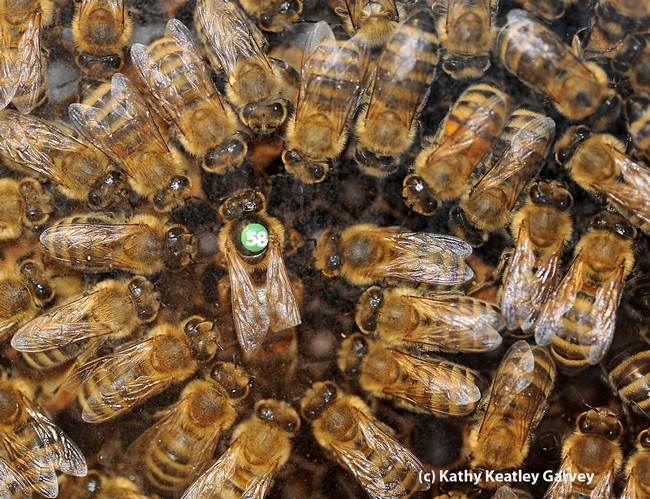
- Author: Kathy Keatley Garvey
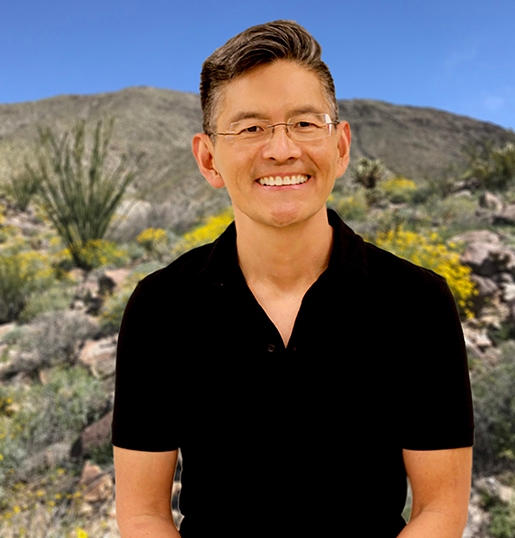
It's a tough world out there for pollinators.
Take it from UC San Diego bee scientist James Nieh, who will be on the UC Davis campus next week to speak on "Animal Information Warfare: How Sophisticated Communications May Arise from the Race to Find an Advantage in a Deadly Game Between Honey Bees and Their Predators."
His seminar, part of the fall quarter seminar series hosted by the UC Davis Department of Entomology and Nematology, will take place at 4:10 p.m., Wednesday, Sept. 25 in 122 Briggs Hall, Kleiber Hall Drive. Fellow bee scientist Brian Johnson, associate professor of entomology, is the host.
"In addition to the classical arm race that has evolved between predators and prey, information races also occur, which can lead to the evolution of sophisticated animal communication," says Nieh, a professor in the Section of Ecology, Behavior and Evolution, Division of Biological Sciences. "Such information can shape the food web and contribute to the evolution of remarkable communication strategies, including eavesdropping, referential signaling and communication within and between species, including between predators and prey."
"I focus on the world of information exchange (acoustic, olfactory and visual) that has co-evolved between Asian honey bees (Apis cerana, A. florea, and A. dorsata) and their predators, the Asian hornets (Vespa velutina and V. mandarinia)," Nieh says in his abstract. "I will explore how and why such information races occur through the remarkable examples provided by these high social insects."
He presented a TED talk on "Bees and Us: an Ancient and Future Symbiosis" in July 2019.
A native of Taiwan, Nieh grew up in Southern California and received his bachelor's degree in organismic and evolutionary biology in 1991 from Harvard University, Cambridge, and his doctorate in neurobiology and behavior from Cornell University, Ithaca, N.Y., in 1997. He subsequently received a NSF-NATO postdoctoral fellowship to study at the University of Würzburg in Germany. A Harvard junior fellowship followed.
Nieh joined the faculty of the Section of Ecology, Behavior and Evolution in 1997 as an assistant professor, advancing to associate professor in 2007 and professor in 2009. He served as vice chair of the section from 2009 to 2014, and as chair from 2014 to 2017.
His latest co-authored research, published in the journal Chemosphere in 2019, is titled Combined Nutritional Stress and a New Systemic Pesticide (flupyradifurone, Sivanto®) Reduce Bee Survival, Food Consumption, Flight Success, and Thermoregulation.
Assistant professor Rachel Vannette is coordinating the fall quarter seminars. Nieh's seminar is the first of the fall quarter. (See list of seminars.) Vannette may be reached at rlvannette@ucdavis.edu.
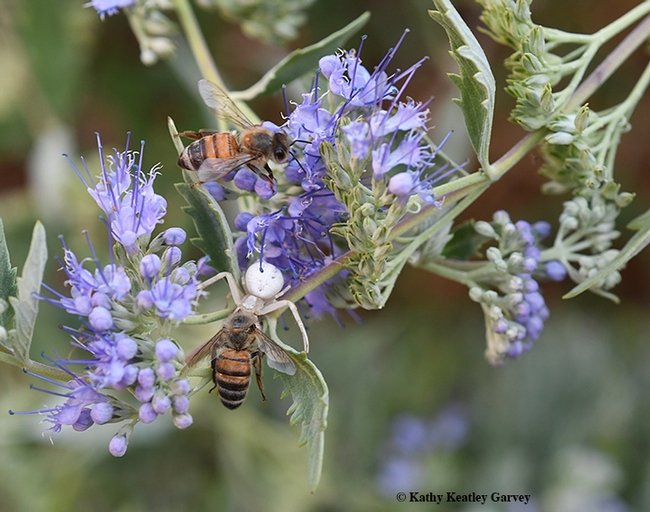
- Author: Kathy Keatley Garvey
Ever seen honey bees engaging in washboarding?
It's a behavior so named because they look as if they're scrubbing clothes on a washboard or scrubbing their home.
It occurs near the entrance of the hive and only with worker bees. They go back and forth, back and forth, a kind of rocking movement. No one knows why they do it. It's one of those unexplained behaviors they've probably been doing for millions of years.
Bee breeder-geneticist Susan Cobey of the University of California, Davis and Washington State University, has witnessed washboarding scores of times. Last week the unusual behavior occurred on two of her hives at the Harry H. Laidlaw Jr. Honey Bee Research Facility at UC Davis. She hypothesizes that these bees are in the "unemployment line." It's a time when foraging isn't so good, so these bees are "sweeping the porch" for something to do, she speculates.
Emeritus professor Norman Gary of UC Davis Department of Entomology writes about it in his chapter, Activities and Behavior of Honey Bees, in the Dadant publication The Hive and the Honey Bee.
"They stand on the second and third pairs of legs and face the entrance. Their heads are bent down and the front legs are also bent," wrote Gary, who has kept bees for more than six decades. "They make 'rocking' or 'washboard' movements, thrusting their bodies forward and backward. At the same time they scrape the surface of the hive with their mandibles with a rapid shearing movement, sliding over the surface as if cleaning it."
They pick up some material and then clean their mandibles.
Gary thinks that "these rocking movements probably serve as a cleaning process by which the bees scrape and polish the surface of the hive."
Like most people, professor/biologist/bee researcher James Nieh of UC San Diego has never seen this behavior. Nieh, who recently presented at seminar at UC Davis, later commented "It is an interesting behavior that would be particularly fascinating to observe in natural colonies in trees. It does seem to involve some cleaning behavior, although it is possible that bees are depositing some olfactory compound while they are rubbing the surface with their mandibles. We are currently conducting research in my lab on the effects of bee mandibular gland secretions on foraging orientation behavior. A new set of experiments will involve examining the effect of mandibular gland secretions on bee behaviors at the nest. I will definitely consider looking at how this potential pheromone affects washboarding."
We managed to capture the behavior with our Iphone and posted it on YouTube.
It's interesting that of the some 25 research hives at the Laidlaw facility, occupants of two of Cobey's hives exhibited washboarding last week.
So, what are washboarding bees doing? Cleaning their home where pathogenic organisms might congregate, per a theory by Katie Bohrer and Jeffrey Pettis of the USDA-ARS Bee Research Lab?
Or are they just creating "busy work"--"sweeping the porch" for something to do?
It would be interesting to find out!
